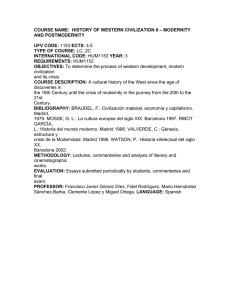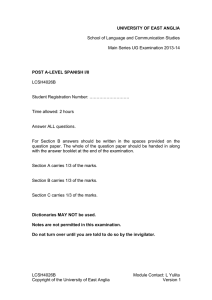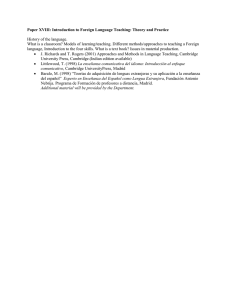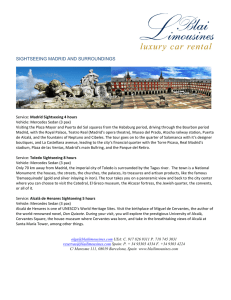An Early Censor: Alejo Venegas
Anuncio
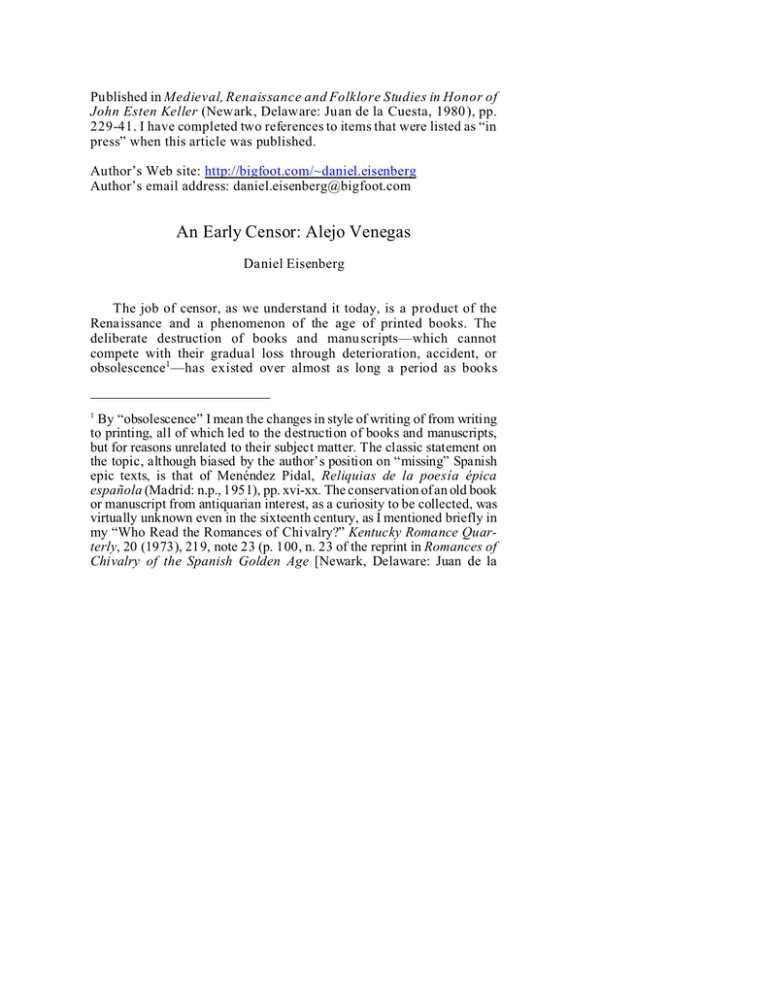
Published in Medieval, Renaissance and Folklore Studies in Honor of John Esten Keller (Newark, Delaware: Juan de la Cuesta, 1980 ), pp. 229-41. I have completed two references to items that were listed as “in press” when this article was published. Author’s Web site: http://bigfoot.com/~daniel.eisenberg Author’s email address: daniel.eisenberg@bigfoot.com An Early Censor: Alejo Venegas Daniel Eisenberg The job of censor, as we understand it today, is a product of the Renaissance and a phenomenon of the age of printed books. The deliberate destruction of books and manuscripts—which cannot compete with their gradual loss through deterioration, accident, or obsolescence1—has existed over almost as long a period as books 1 By “obsolescence” I mean the changes in style of writing of from writing to printing, all of which led to the destruction of books and manuscripts, but for reasons unrelated to their subject matter. The classic statement on the topic, although biased by the author’s position on “missing” Spanish epic texts, is that of Menéndez Pidal, Reliquias de la poesía épica española (Madrid: n.p., 1951), pp. xvi-xx. The conservation of an old book or manuscript from antiquarian interest, as a curiosity to be collected, was virtually unknown even in the sixteenth century, as I mentioned briefly in my “Who Read the Romances of Chivalry?” Kentucky Romance Quarterly, 20 (1973), 219, note 23 (p. 100, n. 23 of the reprint in Romances of Chivalry of the Spanish Golden Age [Newark, Delaware: Juan de la themselves. However, this has been more an ad hoc than a systematic practice; for example, Lope de Barrientos’ famous examination and partial destruction of [p. 230] the books of Enrique de Villena.2 Censorship prior to publication, considering the private and slow nature of medieval book production, seldom existed other than in the mind of the person choosing the work he was about to have copied.3 Cuesta, 1982], 89-118). Even when early Humanists, preparing new, scholarly, or semi-scholarly editions of Classical texts, realized the value of old manuscripts and sought out and used the same, they frequently did not conserve them after finishing the new editions (see the comments of L. D. Reynolds and N. G. Wilson, Scribes and Scholars. A Guide to the Transmission of Greek and Latin Literature, 2nd ed. [Oxford: Clarendon, 1974], p. 124). 2 Emilio Cotarelo y Mori, Don Enrique de Villena, Su vida y obras (Madrid, 1896), p. 110. 3 One exception are the books produced commercially for students’ use (H. J. Chaytor, From Script to Print [Cambridge, England: W. Heffer, 1950 reprint of 1943 ed], pp. 136-37), in which some outside authority chose, like today’s textbook, the books which were, and were not, to be produced. However, this choice was primarily in the field of law, secondarily in theology, and never in literature. The examination of an individual book referred to by Chaytor (p. 136) was to verify its “correctness” in the most literal sense, and it is greatly to Spain’s credit that this salutary practice was followed over quite some period of time (F. J. Norton, Printing in Spain, 1501-1520 [Cambridge, England: Cambridge University Press, 1966], p. 119; Agustín G. de Amezúa y Mayo, “Cómo se hacía un libro en nuestro Siglo de Oro,” first published Madrid: Magisterio Español, 1946, included in his Opúsculos histórico-literarios, I [Madrid: CSIC, 1951], 331-73, at 355). More than the invention itself, it was the rapid spread of printing and the decreasing cost of book pu blication, combined with the nearly simultaneous emergence of new ideas to be circulated through this new technology, that made systematic, organized, and official censorship a logical development. In Spain, this “boom” of publication is commonly and correctly associated with the Reyes Católicos, who—one of their most enlightened and long-lasting policies4—legally and economically supported the fledgling industry, without any known interference with the contents of books published (Norton, pp. 119-20 ). Censorship in Spain, in fact, is [p. 231] commonly dated from the publication of the first two lists of prohibited books in 1551,5 two generations later, 4 More permanent than the unification of Castile and Aragón, more effective than the mostly symbolic conclusion of the reconquista, and more beneficial than the expulsion of the Jews. Almost certainly we can attribute this idea to Isabel, by all accounts the more intellectual of the pair, and the owner of a significant private library (the contents of which are itemized by Diego Clemencín in Elogio de la reina Católica Doña Isabel, Memorias de la Real Academia de la Historia, 6 [Madrid, 1821, and reprint by Kraus Reprint, Liechtenstein, 1968 on the title page, and 1969, apparently the correct date, on the title page verso], pp. 431-81; see also Francisco Javier Sánchez Cantón, Libros, tapices y cuadros que coleccionó Isabel la Católica [Madrid: CSIC, 1950]). 5 Most handily available together with much other useful material, in Die Indices Librorum Prohibitorum des sechzehnten Jahrhunderts, ed. Fr[anz] Heinrich Reusch, Bibliothek des Literarischen Vereins in Stuttgart, 176 (1886; rpt. Nieuwkoop: B. de Graaf, 1961), a companion to the editor’s Der Index der verbotenen Bücher, Ein Beitrag zur Kirchen- und Litteraturgeschichte (Bonn: M. Cohen and Son, 1883-85). Archer Huntington subsidized the reproduction in facsimile (by the De Vinne Press, New York, 1896) of these two indices, as well as the related Censura creating the mistaken impression that censorship was subsequent to the Council of Trent and to most of the reign of Carlos V. Yet this dating of censorship in Spain is incorrect; a more accurate starting date might be the first prohibition of a specific work or works, those of Luther, prohibited in 1521 by Carlos V’s enormously unpopular regent and inquisitor Hadrian.6 This misconception has come to be simply because “es bien poco lo que de eso [la censura] sabemos en la generalis contra errores, quibus recentes haeretici sacram scripturam asperserunt (Valladolid: Francisco Fernández de Córdoba, 1554) and the Mandament der Keyserlijcker Maiesteit [Carlos V] (Louvain: Servaes van Sassen, 1546) the same year, and the much more serious index of 1559 in 1902. Since all of these were in editions of 100 copies, and are now rarities of themselves, the two lists of 1551 and that of 1559 were reproduced also in facsimile by the Real Academia Española in 1952 as the volume Tres índices expurgatorios de la Inquisición española en el siglo XVI. 6 To my knowledge, it has escaped the attention of nationalistic critics and students of the comunero revolt that the Spanish people, to whom Luther was, at this time, more a distant figure than an immediate peril, saw the prohibition of books as yet another unwanted Flemish innovation. The removal of Hadrian, Carlos’ regent during his absence from Spain, was a main goal of the comuneros. [His former student Carlos then played a major role in his obtaining the position of Pope Hadrian VI.] The Prohibition of Hadrian was reaffirmed in 1530 by Alonso Manrique de Lara, later Inquisitor General, another defender of Carlos during his time of difficulty. And the model for the Spanish indices of 1551 was that which Carlos had requested in 1546 of the University of Louvain (reproduced in Die Indices, cited in the previous note). primera mitad del siglo XVI”7 Therefore, [p. 232] this article will present some hitherto little-known information about one of the first Spanish censors, one whose intellectual career falls largely between 1521 and 155 1: Alejo Venegas del Busto (1498/99-165 2). 8 Venegas is a particularly interesting figure to examine because of his associations with the city of Toledo and later that of Madrid. Venegas was born, educated, and worked for a good part of his life in Toledo, in constant and close contact with the ecclesiastical authorities of this religious center.9 Rather than an unimportant person in a small 7 Antonio Sierra Corella, La censura de libros y papeles en España y los indices y catálogos españoles de los prohibidos y expurgados (Madrid: Cuerpo facultativo de archiveros, bibliotecarios y arqueólogos, 1947), pp. 93-94. The most recent comments on Spanish censorship with which I am familiar, those of Keith Whinnom, in “The Problem of the ‘Best-Seller’ in Spanish Golden Age Literature,” Bulletin of Hispanic Studies, 57 (1980), 1898-98, at p. 190, similarly suggests that censorship was a post-Tridentine phenomenon. (Whinnom’s article is reprinted in his Medieval and Renaissance Spanish Literature, ed. Alan Deyermond, W. F. Hunter & Joseph T. Snow [Exeter: Univ. of Exeter Press with the Journal of Hispanic Philology], pp. 159-75.) 8 Also spelled “Venegas.” On his name, see Juan Bautista Avalle-Arce, “Los testamentos de Alejo Venegas,” in Dintorno de una época dorada (Madrid: José Porrúa Turanzas, 1978), 137-72, at p. 143. (this article was originally published in Anuario de Letras, 6 [1966-67], 135-62). 9 I have discussed this to some extent in my introduction to a facsimile edition of Venegas’ Primera parte de las Diferencias de libros que ay en el universo (Barcelona: Puvill, 1983). For another piece of evidence, note his references to the “muchas pláticas y conversaciones particulares” with Pedro de Campo, canónigo de Toledo and professor of theology, in town, we have in Venegas a person of considerable scholarly reputation in a major Castilian city; parallel with Toledo’s dwindling intellectual importance during this period,10 as it lost ground to the new centers of Madrid and Alcalá, Venegas moved about 1544 to Madrid, in which city he continued his censorial activities. He is therefore, not only a person about whom some significant information is known, but he is at least geographically a representative figure; for reasons to be explained shortly, he can be taken as a representative of early Spanish censorship, and perhaps of all censorship, at its best. Venegas was born to a noble but undistinguished Toledan fam[p. 233]ily.11 Although never wealthy—more to the contrary—he was able to study at the “estudio” (after 152 0, University) of Toledo. Presumably his studies were extensive, because he achieved considerable competence in Greek, Latin and Hebrew, to the point that he could write a NBAE, 16, 109b, and Campo’s comment on 107b. 10 There is no single accurate and up-to-date source from which to obtain an appreciation of Toledo’s role in the early sixteenth century. The inaugural speech in the Real Academia de la Historia of the Conde de Cedillo, Jerónimo López de Ayala, Toledo en el siglo XVI después del vencimiento de las comunidades (Madrid, 1901), is uncritical as well as dated. Sounder scholarship, to some degree relevant to the sixteenth century, may be found in Eloy Benito Ruano, Toledo en el siglo XV. Vida política (Madrid: CSIC, 1961). The ringing words of his introduction (pp. 9-10) set forth well Toledo’s special importance for Castile as a whole. 11 For documentation and a fuller summary of Venegas’ life, see my introduction cited in note 9. treatise on the orthography of these languages,12 and because those who knew him in Toledo write unanimously in favorable terms about his learning. His studies continued at least until obtaining the degree of maestro sometime between 1531 and 1537. An ecclesiastical career would have been a likely one for such a talented young man, but became impossible after his marriage, whose date and circumstances are unknown to us. However, a career as professor, which he was to follow throughout the rest of his life, was also in harmony with his knowledge and the methodical, organizing, and expository approach we find in all his works. In Toledo, Nicolás Antonio tells us he founded a Latin school,13 and he was to teach in the university where he had studied. Later, he was invited to occupy the Cátedra de Gramática del Estudio de Madrid, the same position subsequently held by Cervantes’ teacher, López de Hoyos. Among Venegas’ students are counted Francisco Cervantes de Salazar, whom Venegas called “mi discípulo,” 14 and Rivadeneyra. 12 Tractado de orthographía y accentos en las tres lenguas principales (Toledo: Lázaro Salvago, 1531), discussed briefly by Conde de la Viñaza, Biblioteca histórica de la castellana (Madrid, 1893), cols. 1099-1101, used extensively by Amado Alonso, De la pronunciación medieval a la moderna en español, ultimado y dispuesto para la imprenta por Rafael Lapesa (Madrid: Gredos, 1967 [2nd ed. Of Vol. 1]-69, and analyzed by myself in my introduction, already referred to. 13 14 Bibliotheca hispana nova, I (Madrid: Sancha, 1783), 8-9. In the final (unpaginated) page of Venegas’ prologue to the second work (Appólogo [sic] de la ociosidad y el trabajo…compuesto por…Luis Mexía) of the Obras of Cervantes de Salazar (Alcalá: Juan de Brocar, 1546). In addition to his professorial activities, Venegas is the author of several important books. Besides the orthographical treatise already mentioned, he is the au thor of Agonía del tránsito de la muerte, [p. 234] called by Marcel Bataillon “la obra maestra de la literatura ascética española en la época de Carlos V.” 15 It is a handbook on death and dying for the use of the living who should always be ready, spiritually and temporally, for that event which awaits all of us and all of our loved ones. The Agonía was first published in 1537, added to by the author in 1543, and gained reputation as a classic; twelve editions were published between 153 7 and 1682. It is available to modern readers in the edition of Migu el Mir (Escritores místicos españoles, I—though Venegas is not a mystic, as Mir admits on p. xxvii—, NBAE, 1 6 [Madrid: Bailly-Baillière, 1911], 105-318), and there have been some fragmentary editions based on this one16. Venegas is also the author of a much less well-known work, the Primera parte de las diferencias de libros que ay en el universo, of which five editions were published, from 1540 to 1583. Conceived of as a work of bibliographical guidance, the part which was published, and which apparently is the only part Venegas completed, deals with metaphorical “books”: an archetypal book (the term is Venegas’), which only God and those in heaven can read, and three imperfect copies of it, a book of the natural world, a book of reason, and a book of revelation or holy writings. “Books” as we understand them would be copies of these three books, or second copies—full of errors—of the 15 Erasmo y España, trans. Antonio Alatorre, 2nd Spanish edition (Mexico City: El Colegio de México, 1966), p. 565. 16 M[anuel] A[ltolaguirre] (Santiago de Chile: Cruz del Sur, 1948), and of Rafael Fiol (Madrid: Rialp, 1969). original, master book.17 Venegas’ activities as censor are known to us primarily through his own words, found in preliminary matter of his own works, those of his friends, and those sent to him for examination. The best and almost the only known of these is the brief note at the beginning of Antonio de Torquemada’s Coloquios satíricos (reproduced in Orígenes de la novela, II, NBAE, 7 [Madrid: Bailly-Ballière, 19 07], 48 6), in which Venegas states that he ordered changes before publication. At greater length, Venegas discusses the corrections necessary in Agustín de Almazán’s translation of León Baptista Alberti’s Moral e muy graciosa historia del dios Momo (Alcalá, 1553): “Yo he visto estos quatro libros del Momo, que debaxo de poesía [p. 235] juglar, tratan alta philosophía moral. E digo que con las emiendas que yo en él tengo hechas, es un libro muy útil y provechoso, no menos a los príncipes que a los súbditos. Las emendaciones no son faltas del intérprete, que muy bien e fielmente trasladó estos libros, mas fueron incurias del autor, cuyas emiendas fueron necessarias al libro.” Similarly, at the beginning of the Rissa y planto de Demócrito y Heráclito of Antonio Fregoso, translated by Alonso de Lobera (Valladolid, 1554), there is found a “Carta del maestro Alexio de Venegas vezino de Madrid, a quien por el Consejo Real fue encommendado el examen deste libro.” In it, Venegas says: “Yo el maestro Alexio Venegas digo, que e visto y examinado todo este libro, y aun que el trasladador se uvo en él fielmente, por trasladar el sentido del auctor, digo que porque algunos italianos son en algo platónicos, con las emiendas y censuras que yo en él tengo hechas, assí como van en este original, queda libro sano y de buena 17 See note 9. y moral doctrina.” 18 Also, though he does not discuss any changes, we have evidence of his examination of numerous manuscripts in his words at the beginning of the Arismética práctica y especulativa of Juan Pérez de Moya (Salamanca, 1562, but I quote from the edition of 1609): “Alguna razón tengo yo de dar testimonio deste presente libro, porque entre otros libros que nuestro muy alto rey Don Felipe el segundo, monarca del orbe nuevo, quando por cámara despachava su Magestad la impressión de los libros, me mandó que viesse y examinasse, para que dellos diesse mi parecer, fue este libro, el qual yo vi y con diligencia examiné.” However, Venegas’ original job, later to be continued in Madrid 19 and to lead to his pre-publication examination of manuscripts, was the “oficio de visitar los libros que vienen a esta ciudad de Toledo.” 20 He was, then, employed by the ecclesiastical authori[p. 236]ties of Toledo to examine the novedades, presumably about the time they arrived and 18 Since Venegas states the translations are accurate, a comparison of the originals with the translations—something possible in no American library—could permit a better understanding of Venegas’ emiendas in these works. A topic for a future researcher. 19 In a late document, dated by Antonio Paz y Melia (Papeles de inquisición, Catálogo y extractos, 2nd ed. by Ramón Paz [Madrid, 1947], p. 459) in 1560, Venegas asks for “algún socorro…[por] lo que a servido en la visita de las librerías públicas y particulares” (Archivo Histórico Nacional, Papeles de Inquisición, legajo 4442, número 25). 20 Prologue to the Harpa de David of Fray Benito Villa (Burgos: Juan de [p. 236] Junta, a costa de Juan de Medina, 1548). Ironically, and testimony of Venegas’ reasonable outlook, this book itself was to be prohibited, in the Index of 1559 (see note 5 above). were put on sale, in order to confirm that no works were being sold which had not been submitted for approval of the archbishop (Norton, p. 119 ). His words suggest more concern with books imported from other cities or abroad than with those produced in the city of Toledo itself. These pieces of information are most incomplete. We cannot tell from them whether Venegas vetoed the publication or sale of certain books, or which they were, though considering his statement (in the 1545 edition of the Diferencias de libros, fol. 2r) that it is insufficient merely to declare books “inútiles y dañosos,” it would not be out of keeping with his outlook for him to have done so. Similarly, we do not know what corrections he ordered in the works whose publication he permitted. Yet even when this information is lacking, there are illuminating questions to be asked and answered concerning Venegas’ activities as censor, and we can provide, indirectly, information relative to the above. There are at least two important questions that we can respond to concerning Venegas’ employment as censor. These are: first, why was he, rather than another, asked to take on this important job? Secondly, why did he accept it, and what did he hope to accomplish? Related to this, of course, is the qu estion of his censorial practices. On the first question, why was he offered this position, there is a superficial answer: that the Inquisitorial authorities were aware of his difficult financial situation,21 and wished to help him with this part-time 21 See the famous passage to this effect in NBAE, 15, 317-18. Later in his life, Venegas gives us direct information about his economic difficulties in the document cited in note 19, in a petition to the Consejo de Madrid (Eulogio Varela Hervías, “Sobre Alejo de Vanegas [1554],” Correo Erudito, 1 [1940], 83, and also in Varela’s book, Un aspecto de la labor cultural del Ayuntamiento de Madrid [Madrid, 1949], pp. 17-18), and in and probably irregular employment. Yet surely this reason counted little compared with the inquisitors’ concern for the proper exercise of the job, and with their knowledge of Venegas’ qualifications. In striking contrast with modern censorship, usually carried out by persons of limited education and uncertain esthetic principles, Venegas was widely held to be one of the smartest, best-educated, and wisest men to be found in the city of Toledo. Besides being, in the words of his professor and friend Alonso Cedillo, “en sí muy virtuoso y zeloso del servicio de Dios” letter to Venegas’ Tractado de orthographía), numerous sources concur in his considerable learning. In the words of Juan Ginés de Sepúlveda, he was a “varón muy versado en Humanidades y en Sagrada Teología:22 Alfonso García similarly praises him in his De adserenda Hispanorum eruditione,23 and Pedro de Campo, canon of T oledo, praises his learning in a prefatory letter to the Agonía del tránsito de la muerte (NBAE, 16, 107). If one must have a censor, then better by far that it be a man of learning than the general’s wife who, folklore has it, often carries out his will, in which he complains “es poca la sustancia de mi poure [“proue,” en el artículo de Avalle-Arce] hacienda para repartir entre tantos hijos como Dios Nuestro Señor fue seruido de darme” (first published by J. R. Cabezalí, “Tránsito de la muerte del maestro Alejo Venegas,” Revista Bibliográfica y Documental, 3 (1949), 291-302; I cite from the reprint by Juan Bautista Avalle-Arce in Dintorno de una época dorada, p. 157.) 22 P. 224 of the edition of Ángel Losada of Sepúlveda’s letters (Madrid: Cultura Hispánica, 1966). 23 P. 229 of the edition of José López de Toro, Anejo 28 of the RFE (Madrid, 1943). such a function in the modern military dictatorships24 where extensive censorship exists or has existed. In one sense, rather than a censor, Venegas resembles more what we would call an editor or asesor literario, persons who today decide what will and [p. 238] will not be published, specifying, at times, the enmiendas y correcciones necessary before publication is permitted. A person of equivalent learning, prestige, and conscience would probably not accept, today, the sort of position which Venegas held. What are the reasons which led him to carry out this function? There are, again, superficial answers: economic need on the one hand, and the different value system of an intensely religious, fervently Catholic, and recently unified peninsula. Yet we can add three key points to these reasons. The first of these is Venegas’ personality, of which his Catholicism was an integral part. His religious outlook, bringing with it a respect for authority as well as willingness to exercise it upon request, is as deep as can be found in any author of this period. His contemporaries, such as 24 As a curiosity, it is worth citing, as an example of the yet-unstudied scholarship of the Franco period, the opening words of the study of Sierra Corella cited in note 7: “Sólo algún pobre escritor, contagiado, desgraciadamente, de un liberalismo trasnochado, podrá ya en lo sucesivo combatir, con apariencias de convencimiento, el ejercicio legal de la censura científica y literaria, como si esta función vital de la sociedad en general fuese una enojosa e injusta intromisión del poder” (p. 17). And later: “Lutero y sus partidarios no tardaron en difundir sus errores, recurriendo no solamente a la palabra hablada, sino principalmente a la siembra de folletos y libros en todos los pueblos, vecinos o lejanos, y por medios más ingeniosos y audaces” (p. 92). Similarly, at about the same time, we can find Amezúa (“Cómo,” p. 339) praising the fact that censorship prevented the original publication of Quevedo’s first Sueño. Cedillo, speak of his virtuous and Christian life; from his wills and his Agonía we receive the image of a thoughtful and Catholic, as well as a learned, man. From the prefatory letters of his own which were published with his works, we can see how he sent his books to religious figures with an apparently sincere plea for their evaluations and possible corrections. Related to this is Venegas’ outlook as maestro. This was both his profession and his highest degree, a title which he apparently preferred be used in referring to him (the term is always found with his name in his writings subsequent to 1537, the terminus ante quem for his receipt of the degree). Throughout Venegas’ writings—both in the selection of topics and in the presentation of the material within them—his didactic orientation is clear. Rather than a scholar who theorized or sought old manuscripts, Venegas was an author who organized, structured, defined, and explained: a teacher, in short, by disposition. Determining what people should read— a widespread if less official activity in today’s academic world— is a form of instruction, and would have seemed a sensible enterprise to him. Finally, we must mention Venegas’ love of books and reading. His most ambitious authorial project, so ambitious that it was never completed, was that familiar product of poor bibliophiles, a bibliography (the Diferencias de libros), and one, moreover, whose explicit purpose was to classify books so as to help the reader choose the appropriate ones for himself or for persons under his care. Like the regular book reviewer of today, to be paid to exam[p. 239]ine texts which one therefore did not have to buy must have been an opportunity not to be missed. However, Venegas’ interest in censorship, like his plan to write a work of bibliographical guidance, may reflect some personal observation of a link between improper reading and un-C hristian, dissolute living. Specifically, I refer to the activities in the house of the Duque del Infantado, Diego Hurtado de Mendoza.25 Mendoza’s licetntious and later ludicrous lifestyle was fairly widely known,26 but there are two avenues through which Venegas could have had direct information. The first of these is through the Mélito house of Toledo, another branch of the large Mendoza family, with which, we can tell from the dedication to the Agonía del tránsito de la muerte, Venegas had close contact. The second is via one of the persons Venegas most admired, Álvar Gómez de Ciudad Real, a significant Toledan humanist of exemplary life, who was married to one of the several illegitimate daughters of the Duque del Infantado. 27 The interest of the Duque del Infantado in romances of chivalry, at that point at the peak of their popula rity, is known.28 Could it be a coincidence that Venegas is virtually the initiator of the tradition of learned attacks on romances of chivalry, which was to last for a century 25 A popular name. This Diego Hurtado de Mendoza, who died in 1531 and lived in Guadalajara, should not be confused with the Toledan Diego Hurtado de Mendoza, Count of Mélito, after whose death in 1536 Venegas began the Agonía del tránsito de la muerte, dedicated to his widow, nor with the Granadine Diego Hurtado de Mendoza (1503?-1575), the poet, diplomat, and author of the Guerra de Granada. 26 See my “Two Problems of Identification in a Parody of Juan de Mena,” Oelschläger Festschrift, Estudios de Hispanófila, 36 (Chapel Hill, 1976), pp. 155-60. 27 For information on Gómez and on Venegas’ interest in him, see my introduction cited in note 9. 28 I have mentioned it in my article cited in note 26, as well as in “Who Read the Romances of Chivalry?” cited in note 1. and find ample reflection in the Qu ijote? 29 [p. 240] T wo writers often cited as predecessors are only partly that. Juan de Valdés’s Diálogo de la lengua, which is not particularly hostile to the romances, was virtually unknown until its publication in the eighteenth century, and had no influence on the later critics. Vives was hostile, to be sure, but for him the romances were merely one part of a broader spectrum of objectionable literature, particularly literature in the vernacular; Vives’ translator Cervantes de Salazar, who amplified his comments on romances of chivalry, was, as has already been mentioned, Venegas’ student.30 The identification of the romances with the antithesis of good literature scarcely antedates Venegas’ comment in an epilogue to the Theológica descriptión de los misterios sagrados of Álvar Gómez de Ciudad Real (Toledo, 1541; facsimile, Cieza, 1965), a work with whose publication Venegas was associated: "Dízese milesia de la ciudad de Mileto…. En esta fábula escrivió Apuleyo su Asno dorado, y Mahoma escrivió su Alcorán, y todos los milesios escrivieron sus cavallerías Amadísicas y Esplandiánicas hervoladas.” 31 29 For references to these criticisms, see notes 4 and 5 to Chapter II of my Romances of Chivalry in the Spanish Golden Age. The best discussions of these criticisms, placing them in the context of Renaissance literary theory, remains that of Alban Forcione, Cervantes, Aristotle, and the Persiles (Princeton University Press, 1970), Parts One and Two. 30 Vives and his translator are both cited by Henry Thomas, Spanish and Portuguese Romances of Chivalry (1920: rpt. New York: Kraus Reprint, 1969), pp. 161-66. 31 Although the above is posed as a question, what is certain is Venegas’ initiation of the identification of the mysterious Milesian fables with the Spanish romances of chivalry (see my introduction, already cited), although It is well known that romances of chivalry—secular ones, at any rate 32—were never censored. W hile this fact reflects well on the practice of censorship in sixteenth-century Castile, it is worth pointing out that Venegas may have set a model by himself declining to act against any of them. There are two possible explanations for this inaction: first, Venegas’ statements about the romances strongly suggest that he had never read one, and they contrast with his comments on the works he censored, which he had [p. 241] indeed read. Secondly, perhaps more likely, is the fact that whatever the social effects of the romances, their religious orientation, basically that of the Crusaders, was very unexceptional. Whatever Venegas’ feelings as a private scholar, his official function was to eliminate religious error. Beyond the above I am not going to defend Spanish censorship, just as I would not defend the expulsion of the Jews, the execution of heretics, the blood laws, or any one of a number of similar measures which are offensive to us moderns, no matter how laudable they seemed to contemporaries. But I would suggest that the picture is not exclusively black. The choice, first in Toledo and later in Madrid, of such an educated, Christian, and modest man suggests that censorship, at least during this early period, was being intelligently and carefully exercised. such identification is frequently credited to such later authors as Cervantes’ source, López Pinciano. On the Milesian fables, whose alleged relationship to Spanish literature I hope to discuss more fully on another occasion, see Alexander Scobie, Apuleius Metamorphoses, I: A Commentary (Meisenheim am Glan: Anton Hain, 1975), pp. 66-67, and for their context, Arthur Heiserman, The Novel before the Novel (Chicago and London: University of Chicago Press, 1977), in which they are discussed in Chapter 8. 32 On the romances of chivalry a lo divino, see my book cited in note 1. F LORIDA S TATE U NIVERSITY

